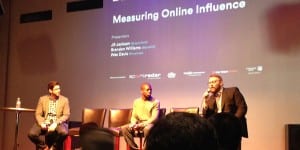 When I first moved to New York City in 2012, I had a random Craig’s List roommate who claimed to be a “sports blogger.” In reality, he worked as an associate at Barney’s and tweeted, wrote and ranted about sports in his spare time. He also attended the Blogs with Balls Conference every year and insisted that it was the next big thing in sports journalism.
When I first moved to New York City in 2012, I had a random Craig’s List roommate who claimed to be a “sports blogger.” In reality, he worked as an associate at Barney’s and tweeted, wrote and ranted about sports in his spare time. He also attended the Blogs with Balls Conference every year and insisted that it was the next big thing in sports journalism.
At the time, I just figured it was a bunch of sports “nerds” in a basement (which it technically was, at first). In reality, my then-roommate was right: Just three years later, Blogs With Balls is filled with everyone from PR guys like me, to people who get paid to blog about sports, to the NFL Players Association.
My Ketchum Sports & Entertainment colleague, Brandon Williams, was a moderator for the “Measuring Online Influence” panel. We attended Blogs With Balls 6 in Chicago just days before the NFL draft to get a glimpse into the future of sports coverage.
One of the biggest takeaways: You don’t need a background in journalism to become a source, or even a sought-after personality, in sports media today. Those guys who used to blog about the NBA from their dorm room are now blogging about the NBA for CNN, and are getting paid by brands to integrate products in the process.
What we learned was more than just how to work with these bloggers or how to approach them as PR folks, but how sports coverage is evolving in the era of modern technology.
As the moderator of the Measuring Online Influence panel, Brandon kicked off the day’s festivities with a lighthearted, informative discussion about the current state of today’s brand ambassador, and the influence gained from having a “tuned-in” social media presence. He was joined by JR Jackson, a sports media personality with over 100K YouTube subscribers, and Wes Davis, content director for MVP Index – an online analytics index that measures the influence and reach of athletes around the world.
Topics ranged from what brands are truly looking for in an authentic spokesperson in today’s fast-paced, an “always monitored” social media world, and the various ways that “Internet Superstars” are looking to monetize their influence.
Here are five key takeaways from #BWB6 that resonated with us:
1. It’s All Just “Media”
Forget “traditional” and “new” media – everything today is just media. Call it a blogger, reporter, or journalist – the lines are blurred, the way that news is covered has truly shifted.
2. Your Pitch Is Futile … Sort of
If you’ve heard it once, you’ve heard it a hundred times but, much like journalists, bloggers get inundated with pitches from people like us. A mail merge with a client-approved pitch isn’t going to help you here. How do you break through? Make it personal, make it worthwhile and keep it short. Work together to make things work for you both, don’t make it a one-sided conversation.
3. Personalization + Authenticity = A Winning Formula
When you are vetting an athlete for an endorsement, paid social media deal, etc. make sure you choose someone who identifies with your brand. Why do sneaker brands love Victor Cruz? Because even if he wasn’t a football star he’d still be Instagramming about sneakers. His endorsements in the sneaker category mean something because he genuinely cares about shoes. As Wes Davis from MVP Index so eloquently put it, “It’s about authenticity now. Brands and influencers that work as partners are the ones that are most effective.”
4. Brevity Rules in These Modern Times
Again, this can be applied to the pitch process but perhaps more importantly to sports media consumption in general. It was pretty crazy, but also totally believable to hear legendary NBA reporter Scoop Jackson say, “I don’t know if I could write an 8,000 word story on Michael Jordan today. I’d lose the reader.” The moral of the story is we only have a short amount of time and space to catch a reader’s attention.
5. Sports Blends Society + Culture
Today, more than ever, sports journalists are being tasked with giving their take on issues that may have previously reached beyond their desks. From LGBT athletes coming out to racial tensions forcing an MLB team to play in front of an empty stadium, sports is now mainstream pop-culture news, and sports media must adapt within this expanding narrative.


